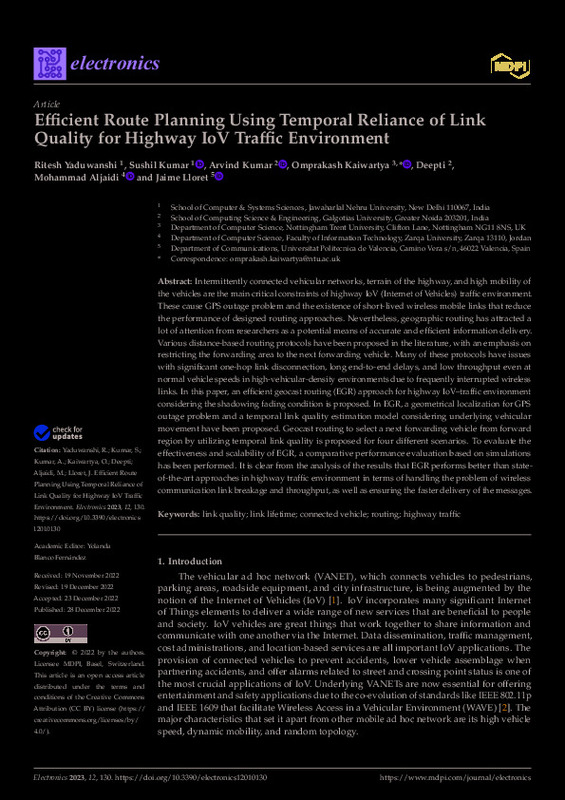JavaScript is disabled for your browser. Some features of this site may not work without it.
Buscar en RiuNet
Listar
Mi cuenta
Estadísticas
Ayuda RiuNet
Admin. UPV
Efficient Route Planning Using Temporal Reliance of Link Quality for Highway IoV Traffic Environment
Mostrar el registro sencillo del ítem
Ficheros en el ítem
| dc.contributor.author | Yaduwanshi, Ritesh
|
es_ES |
| dc.contributor.author | Kumar, Sushil
|
es_ES |
| dc.contributor.author | Kumar, Arvind
|
es_ES |
| dc.contributor.author | Kaiwartya, Omprakash
|
es_ES |
| dc.contributor.author | Deepti
|
es_ES |
| dc.contributor.author | Aljaidi, Mohammad
|
es_ES |
| dc.contributor.author | Lloret, Jaime
|
es_ES |
| dc.date.accessioned | 2024-05-02T18:08:20Z | |
| dc.date.available | 2024-05-02T18:08:20Z | |
| dc.date.issued | 2023-01 | es_ES |
| dc.identifier.uri | http://hdl.handle.net/10251/203924 | |
| dc.description.abstract | [EN] Intermittently connected vehicular networks, terrain of the highway, and high mobility of the vehicles are the main critical constraints of highway IoV (Internet of Vehicles) traffic environment. These cause GPS outage problem and the existence of short-lived wireless mobile links that reduce the performance of designed routing approaches. Nevertheless, geographic routing has attracted a lot of attention from researchers as a potential means of accurate and efficient information delivery. Various distance-based routing protocols have been proposed in the literature, with an emphasis on restricting the forwarding area to the next forwarding vehicle. Many of these protocols have issues with significant one-hop link disconnection, long end-to-end delays, and low throughput even at normal vehicle speeds in high-vehicular-density environments due to frequently interrupted wireless links. In this paper, an efficient geocast routing (EGR) approach for highway IoV-traffic environment considering the shadowing fading condition is proposed. In EGR, a geometrical localization for GPS outage problem and a temporal link quality estimation model considering underlying vehicular movement have been proposed. Geocast routing to select a next forwarding vehicle from forward region by utilizing temporal link quality is proposed for four different scenarios. To evaluate the effectiveness and scalability of EGR, a comparative performance evaluation based on simulations has been performed. It is clear from the analysis of the results that EGR performs better than state-of-the-art approaches in highway traffic environment in terms of handling the problem of wireless communication link breakage and throughput, as well as ensuring the faster delivery of the messages. | es_ES |
| dc.description.sponsorship | The research is funded by the School of Computer and Systems Science, Jawaharlal Nehru University, India. | es_ES |
| dc.language | Inglés | es_ES |
| dc.publisher | MDPI AG | es_ES |
| dc.relation.ispartof | Electronics | es_ES |
| dc.rights | Reconocimiento (by) | es_ES |
| dc.subject | Link quality | es_ES |
| dc.subject | Link lifetime | es_ES |
| dc.subject | Connected vehicle | es_ES |
| dc.subject | Routing | es_ES |
| dc.subject | Highway traffic | es_ES |
| dc.subject.classification | INGENIERÍA TELEMÁTICA | es_ES |
| dc.title | Efficient Route Planning Using Temporal Reliance of Link Quality for Highway IoV Traffic Environment | es_ES |
| dc.type | Artículo | es_ES |
| dc.identifier.doi | 10.3390/electronics12010130 | es_ES |
| dc.rights.accessRights | Abierto | es_ES |
| dc.contributor.affiliation | Universitat Politècnica de València. Escuela Politécnica Superior de Gandia - Escola Politècnica Superior de Gandia | es_ES |
| dc.description.bibliographicCitation | Yaduwanshi, R.; Kumar, S.; Kumar, A.; Kaiwartya, O.; Deepti; Aljaidi, M.; Lloret, J. (2023). Efficient Route Planning Using Temporal Reliance of Link Quality for Highway IoV Traffic Environment. Electronics. 12(1). https://doi.org/10.3390/electronics12010130 | es_ES |
| dc.description.accrualMethod | S | es_ES |
| dc.relation.publisherversion | https://doi.org/10.3390/electronics12010130 | es_ES |
| dc.type.version | info:eu-repo/semantics/publishedVersion | es_ES |
| dc.description.volume | 12 | es_ES |
| dc.description.issue | 1 | es_ES |
| dc.identifier.eissn | 2079-9292 | es_ES |
| dc.relation.pasarela | S\491790 | es_ES |
| dc.contributor.funder | Jawaharlal Nehru University | es_ES |








